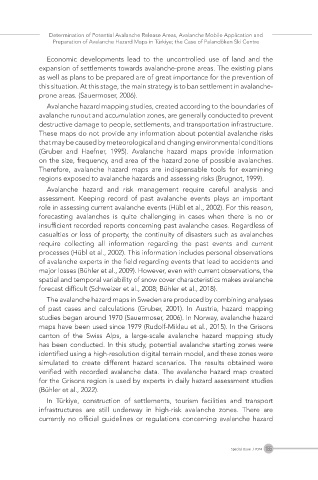Page 168 - Çevre Şehir ve İklim Dergisi İngilizce - Özel Sayı
P. 168
Determination of Potential Avalanche Release Areas, Avalanche Mobile Application and
Preparation of Avalanche Hazard Maps in Türkiye; the Case of Palandöken Ski Centre
Economic developments lead to the uncontrolled use of land and the
expansion of settlements towards avalanche-prone areas. The existing plans
as well as plans to be prepared are of great importance for the prevention of
this situation. At this stage, the main strategy is to ban settlement in avalanche-
prone areas. (Sauermoser, 2006).
Avalanche hazard mapping studies, created according to the boundaries of
avalanche runout and accumulation zones, are generally conducted to prevent
destructive damage to people, settlements, and transportation infrastructure.
These maps do not provide any information about potential avalanche risks
that may be caused by meteorological and changing environmental conditions
(Gruber and Haefner, 1995). Avalanche hazard maps provide information
on the size, frequency, and area of the hazard zone of possible avalanches.
Therefore, avalanche hazard maps are indispensable tools for examining
regions exposed to avalanche hazards and assessing risks (Brugnot, 1999).
Avalanche hazard and risk management require careful analysis and
assessment. Keeping record of past avalanche events plays an important
role in assessing current avalanche events (Hübl et al., 2002). For this reason,
forecasting avalanches is quite challenging in cases when there is no or
insufficient recorded reports concerning past avalanche cases. Regardless of
casualties or loss of property, the continuity of disasters such as avalanches
require collecting all information regarding the past events and current
processes (Hübl et al., 2002). This information includes personal observations
of avalanche experts in the field regarding events that lead to accidents and
major losses (Bühler et al., 2009). However, even with current observations, the
spatial and temporal variability of snow cover characteristics makes avalanche
forecast difficult (Schweizer et al., 2008; Bühler et al., 2018).
The avalanche hazard maps in Sweden are produced by combining analyses
of past cases and calculations (Gruber, 2001). In Austria, hazard mapping
studies began around 1970 (Sauermoser, 2006). In Norway, avalanche hazard
maps have been used since 1979 (Rudolf-Miklau et al., 2015). In the Grisons
canton of the Swiss Alps, a large-scale avalanche hazard mapping study
has been conducted. In this study, potential avalanche starting zones were
identified using a high-resolution digital terrain model, and these zones were
simulated to create different hazard scenarios. The results obtained were
verified with recorded avalanche data. The avalanche hazard map created
for the Grisons region is used by experts in daily hazard assessment studies
(Bühler et al., 2022).
In Türkiye, construction of settlements, tourism facilities and transport
infrastructures are still underway in high-risk avalanche zones. There are
currently no official guidelines or regulations concerning avalanche hazard
155
Special Issue / 2024

